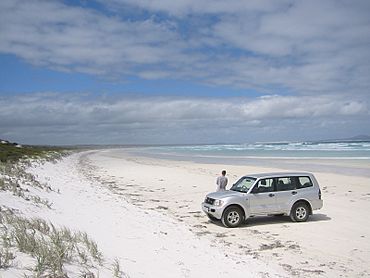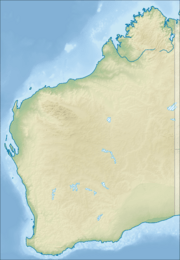Cape Arid National Park facts for kids
Quick facts for kids Cape Arid National ParkWestern Australia |
|
|---|---|
|
IUCN Category II (National Park)
|
|

Yokinup Bay, Cape Arid
|
|
| Established | 1969 |
| Area | 2,794.46 km2 (1,078.9 sq mi) |
| Managing authorities | Department of Environment and Conservation |
| See also | List of protected areas of Western Australia |
Cape Arid National Park is a special protected area in Western Australia. It's about 731 kilometers (454 miles) southeast of Perth. You can find it on the south coast, about 120 kilometers (75 miles) east of Esperance.
The park's coastline stretches along the south coast. On its eastern side is Israelite Bay, a place often mentioned in weather reports. The western end is called Duke of Orleans Bay. The coastline also includes Cape Arid, Sandy Bight, and Cape Pasley.
Contents
History of Cape Arid National Park
The first European to explore this area was a French Admiral named Bruni D'Entrecasteaux in 1792. He called it Cap Aride. Later, in 1802, Matthew Flinders changed the name to the English "Cape Arid." The park gets its name from this feature.
Around the 1870s, early farmers, known as graziers, came to live in the area. You can still find old ruins of their homes, dams, and even gravesites near Pine Hill and Thomas Fishery. Some early fishing activities, including bay whaling, also took place here in the 1860s and 1870s.
Exploring the Environment of Cape Arid
Geography and Landscape
Cape Arid National Park has a mix of sandy beaches and rocky cliffs along its southern edge. Further north, you'll find low granite hills. These hills connect to the rugged Russell Range, which is made mostly of very old quartzite rock.
The highest point in the park is Tower Peak, located in the Russell Range. It stands tall at 594 meters (1,949 feet). The eastern side of the park borders the Nuytsland Nature Reserve. Around the hills, there are sandy plains full of different kinds of plants.
Amazing Animals of the Park
The park is home to many different habitats, which means lots of different plants and animals live here. It's a very important place for birds in Western Australia. Over 160 types of birds have been seen here, including some that are rare or endangered.
Some of the special birds you might find include the western ground parrot, the Australasian bittern, Carnaby's cockatoo, and Cape Barren geese.
Other animals living in the park include the western brush wallaby, quenda (a type of bandicoot), and the southern bush rat. There are also many small marsupial predators, plus a variety of reptiles and amphibians. Scientists even think a rare and ancient type of ant called Nothomyrmecia might live here.
Unique Plants of Cape Arid
The plants in the park mostly grow on young sand dunes. These areas have large groups of coastal heath plants. You'll also find smaller areas with yate trees, banksia plants, paperbark trees, and mallee shrubs.
Near Mount Ragged, you can discover different kinds of orchids and ferns. There's even a small group of a special plant called the sticky-tail flower (Anthocersis viscosa).
Trails and Camping Adventures
The park has many great walking trails for you to explore. Some popular ones include the Len Otte Nature Trail, Tagon Coastal Trail, and Boolenup Walk Trail. You can also hike up Mount Ragged and Mount Arid for amazing views.
The easiest place to camp is at Thomas River. It's accessible by a regular car and has barbecues, toilets, and water tanks. Other campsites, like those at Mount Ragged, Poison Creek, and Deal Creek, can only be reached by four-wheel drive vehicles.
See also
 In Spanish: Parque nacional Cabo Árido para niños
In Spanish: Parque nacional Cabo Árido para niños




